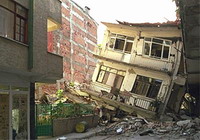Earthquake creates tsunami in western Indonesia
10 people died and many were injured in a massive earthquake that caused a small tsunami in western Indonesia. Warnings of potentially destructive waves were issued across the Indian Ocean region.

The 8.4-magnitude quake off Sumatra island damaged homes, shopping malls and mosques along the coast and could be felt in at least four countries, with tall buildings swaying as far as 2,000 kilometers (1,200 miles) away.
It was followed by a series of powerful aftershocks.
A tsunami - perhaps just a meter- (yard-) high - reportedly struck off the city of Padang, said Suhardjono, a senior official at Indonesia's meteorological agency, adding that severed phone lines were making it hard to get details. The Pacific Tsunami Warning Center also reported a small tsunami.
Most of the damage, however, appeared to come from the tremor.
Two people were killed when a car dealership collapsed and another person died in a fire on the fourth floor of a department store, said Alfin, a witness in Padang, adding that excavation machinery was being used to search through the rubble for survivors.
At least seven people also were killed in and around Bengkulu, a town 400 kilometers (250 miles) away, Social Affairs Department official Felix Valentino told the news portal detik.com. At least 100 others were hospitalized, said Health Ministry official Rustam Pakaya.
Panicked residents fled their homes and ran inland.
"Everyone is running out of their houses in every direction," said Wati Said, who spoke by cell phone standing outside her house in Bengkulu, which was closest to the epicenter of the quake. "We think our neighborhood is high enough. God willing, if the water comes, it will not touch us here. ... Everyone is afraid."
The undersea temblor could be felt in the Indonesian capital, Jakarta, 600 kilometers (375 miles) away, where office workers streamed down the stairwells of tall, swaying buildings. It also caused high-rises to sway in neighboring Malaysia, Singapore and Thailand.
The quake hit at about 6:10 p.m. (1110 GMT), the U.S. Geological Survey said, and was centered 105 kilometers (80 miles) southwest of Sumatra island at a depth of 30 kilometers (18 miles).
"Earthquakes of this size have the potential to generate a widespread destructive tsunami that can affect coastlines across the entire Indian Ocean Basin," the Pacific Tsunami Warning Center said, warning that waves could hit Indonesia and Australia within an hour, and Sri Lanka and India within three.
Indonesia lifted all alerts several hours later, saying there was no longer a potential for a destructive wave.
Tsunami warnings were issued as far away as Africa, with people in Kenya told to leave beaches.
Closer to home, Thailand sent cell phone text messages alerting hundreds of officials in six southern provinces.
In India, officials said nothing was felt in the remote Andaman and Nicobar islands, some of which are just 240 kilometers (150 miles) north of the epicenter. But an alert was issued and local authorities were told to take precautions, said Dharam Pal, the regional relief commissioner.
Sri Lankans were also told to move at least 200 meters (660 feet) inland.
In Australia, the tsunami warning was lifted after only small rises in the sea level were measured at Cocos Island and the Christmas Islands. But officials warned residents to stay away from the ocean, warning that dangerous waves and currents could still affect beaches, harbors and rivers for several hours.
Indonesia, the world's largest archipelago, is prone to seismic upheaval due to its location on the so-called Pacific "Ring of Fire," an arc of volcanos and fault lines encircling the Pacific Basin.
A massive Dec. 26, 2004, earthquake triggered a tsunami off the coast of Sumatra that killed more than 160,000 in a dozen nations, most of them in Indonesia's Aceh province. The 9.0 temblor was 29 kilometers (18 miles) deep, according to USGS.
Subscribe to Pravda.Ru Telegram channel, Facebook, RSS!


